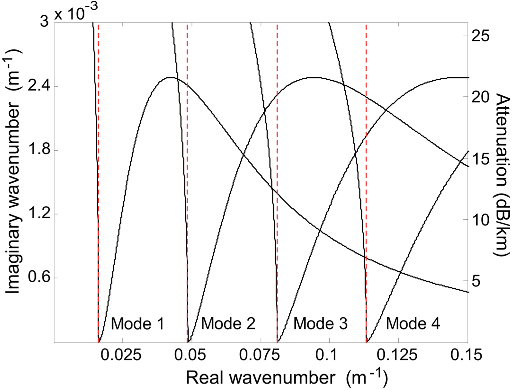




Did you find this useful? Give us your feedback



















252 citations
...In this environment, the intra-modal frequency dispersion is stronger and has an opposite sign than that in a Pekeris waveguide (Duncan et al., 2013)....
[...]
106 citations
...ranges thousands of kilometres from the source when sound travels down the continental slope (McCauley et al., 2008; Duncan et al., 2013)....
[...]
...Further technical details on underwater soundpropagation are included in Supplementary Material A and can be found elsewhere (McCauley et al., 2003a; Duncan and McCauley, 2008; McCauley et al., 2008; Duncan et al., 2013)....
[...]
...…tens of kilometres due to upslope propagation from a seismic source in shallow water over a low reflectivity seabed, whereas other signals may be detectable at ranges thousands of kilometres from the source when sound travels down the continental slope (McCauley et al., 2008; Duncan et al., 2013)....
[...]
27 citations
25 citations
24 citations
...In acoustic modelling studies, specific characteristics of sound propagation over Australia’s continental shelf have been investigated with the help of CHORUS [35]....
[...]
25 citations
...Ellis and Chapman (1985) analyzed phase and group velocities and attenuation of normal modes in shallow water channels, where the shear wave speed in the seabed was lower than the sound speed in water....
[...]
...However, neither Ellis and Chapman (1985) nor Arvelo and €Uberall (1990) considered the frequency-dependence of lowfrequency sound propagation over an elastic bottom in detail....
[...]
...(B5) in Ellis and Chapman (1985): 208 J. Acoust....
[...]
...The numerical predictions made in this section are based on the formulation given in Ellis and Chapman (1985) and the Wave Number Integration (WNI) transmission loss calculation method implemented in computer programs SCOOTER and FIELDS (Porter, 2007)....
[...]
...Lobanov and Petukhov (1993) used the theoretical derivations made in Ellis and Chapman (1985) to explain the space-frequency pattern of the sound field measured from a broadband acoustic source in shallow water over bedrock, but only considered the case in which the shear wave speed was higher than…...
[...]
16 citations
...Duncan et al. (2009) modeled low-frequency sound propagation over calcarenite, which is a type of soft limestone that makes up the majority of the western and southern continental shelves of Australia....
[...]
8 citations
...However, neither Ellis and Chapman (1985) nor Arvelo and €Uberall (1990) considered the frequency-dependence of lowfrequency sound propagation over an elastic bottom in detail....
[...]
...Using an adiabatic mode approximation, Arvelo and €Uberall (1990) modeled the influence of elastic waves in the seafloor and varying bathymetry on acoustic transmission loss in shallow water....
[...]
5 citations
...Lobanov and Petukhov (1993) used the theoretical derivations made in Ellis and Chapman (1985) to explain the space-frequency pattern of the sound field measured from a broadband acoustic source in shallow water over bedrock, but only considered the case in which the shear wave speed was higher than…...
[...]
...Over large areas of the continental shelves this soft sediment layer is thick enough that shear waves in the underlying basement can be ignored when modeling sound propagation in the water column, leading to all-fluid seabed models....
[...]
4 citations
...Chotiros and Isakson (2010) examined sound propagation in the same environment, but using a Biot-Stoll poroelastic model of calcarenite, rather than the elastic model assumed by Duncan et al. Their numerical prediction did not show the narrow frequency banding in the transmission loss predicted by…...
[...]